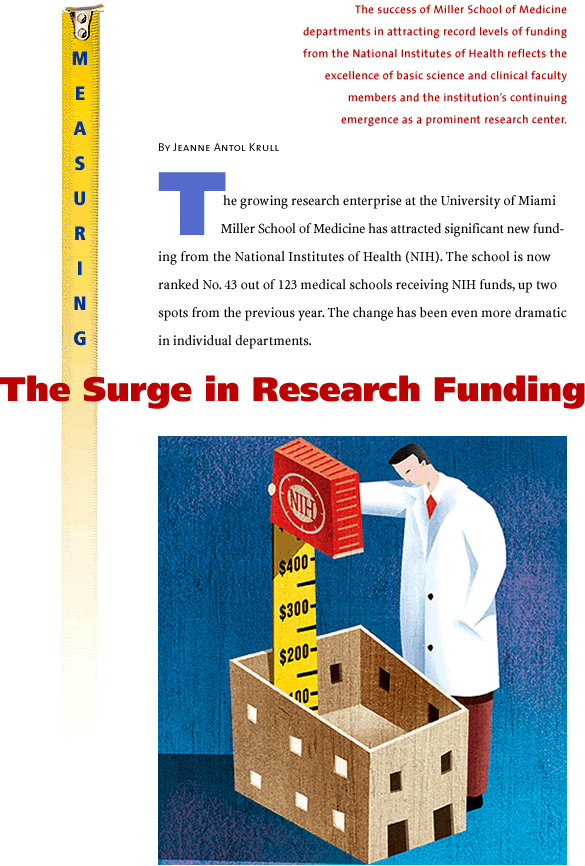
“The increase in NIH funding speaks to the commitment and dedication of both our basic science and clinical faculty members dedicated to research,” says John G. Clarkson, M.D., senior vice president for medical affairs and dean of the Miller School of Medicine. “We anticipate that this upward trend in funding will continue as our research enterprise continues to grow.”
The latest figures released by the NIH represent funding during the federal government’s 2004 fiscal year. The numbers show that nine departments at the Miller School of Medicine ranked in the top third of all medical schools for funding.
“One day we may look back on 2004 as the turning point at the Miller School of Medicine, the year we started seeing a return on our investment and renewed commitment to the research academic mission of the medical school,” says Camillo Ricordi, M.D., senior associate dean for research and scientific director of the Diabetes Research Institute. “This surge in funding shows the key role our centers of excellence play, the importance of recruiting top academic leaders, and the success of our initial investments to develop an integrated and highly competitive shared research infrastructure.”
In less than three years as a separate department, Rehabilitation Medicine has ranked fifth in NIH funding out of 22 departments at U.S. medical schools.
The first year the Department of Neurological Surgery was listed separately from the Department of Surgery was in 2002, when it ranked fourth in funding out of 43 departments. For the past two years, it’s jumped to No. 3.
The Department of Pediatrics has moved four places from No. 33 in 2003 to No. 29 in 2004, with more than $6.7 million in NIH funding.
The DeWitt Daughtry Family Department of Surgery has made tremendous progress, going from No. 50 in fiscal year 2003 to No. 15 in 2004. “We’ve always been very strong clinically because of the enormous patient volume at Jackson Memorial Hospital, as well as being the only tertiary referral center for hundreds of miles,” says Alan Livingstone, M.D., professor and chairman of the Department of Surgery. “About five years ago we decided as a department to actively pursue distinction in research in addition to clinical excellence, and that is now paying off.”
The department started recruiting physician-scientists and now has more than 30 M.D.’s and Ph.D.’s actively doing research. The department also extended its residency program by two years for two physicians, with the added time spent in the laboratory doing research. The academic output in terms of publications and presentations at national meetings has been impressive, Livingstone says.
“To be a successful academic medical center, you must counterbalance your clinical activities with research,” says Livingstone. “We plan to continue to build on that philosophy, as we currently have 60 research grants pending with potential funding in excess of $35 million.”
The Department of Ophthalmology has steadily moved up the NIH award rankings. In 2001 the department was ranked 34th out of 67 departments. In fiscal year 2004 the department came in at No. 18. Research funding has grown from $2.5 million in 2002 to almost $8 million for the current fiscal year.
“When Carmen Puliafito arrived as chairman in 2001, he launched an ambitious effort to build the laboratory research enterprise at Bascom Palmer Eye Institute. We kicked the plan into high gear when I arrived a year later as his first research faculty recruit. It’s now yielding impressive results,” says M. Elizabeth Fini, Ph.D., scientific director, professor of ophthalmology, and the Walter G. Ross Chair in Ophthalmic Research.
“One of the keys to our current success has been to cast a broad net to bring in the best scientists, interest them in studying important problems in eye disease, then build on those resources. At the same time, we’ve been working on ways to leverage one grant to bring in the next,” Fini explains.
One of the biggest recent research accomplishments was the award of a new five-year core grant for vision research that re-established Bascom Palmer Eye Institute as a Research Center of the National Eye Institute. The prestigious award supports the activities of the Miami Center for Vision Research of Bascom Palmer’s Evelyn F. and William L. McKnight Vision Research Center.
“Establishing the MCVR as a cross-campus organization increases the opportunities for multidisciplinary research collaborations. The center includes more than 60 faculty-level scientists and physicians who collaborate in the laboratory or in the clinical programs,” says Fini, who is also the center’s founding director and principal investigator for the grant.
“To have this significant increase in funding is very exciting and all the more meaningful considering the tight budget constraints recently imposed by the NIH,” says Norman H. Altman, V.M.D., vice provost for research at the Miller School of Medicine. “Clearly this indicates we are well on our way to even further national prominence as a research institution.”